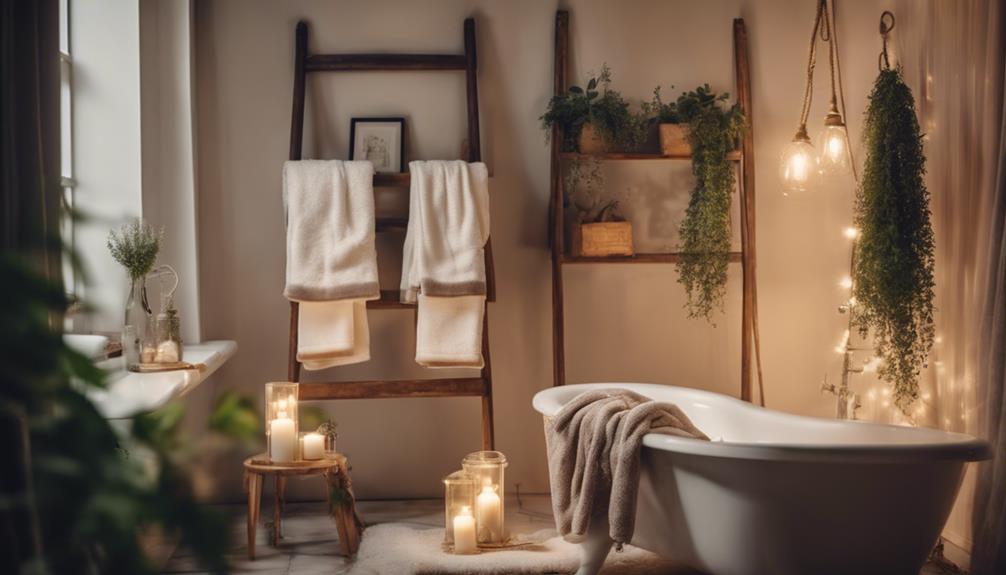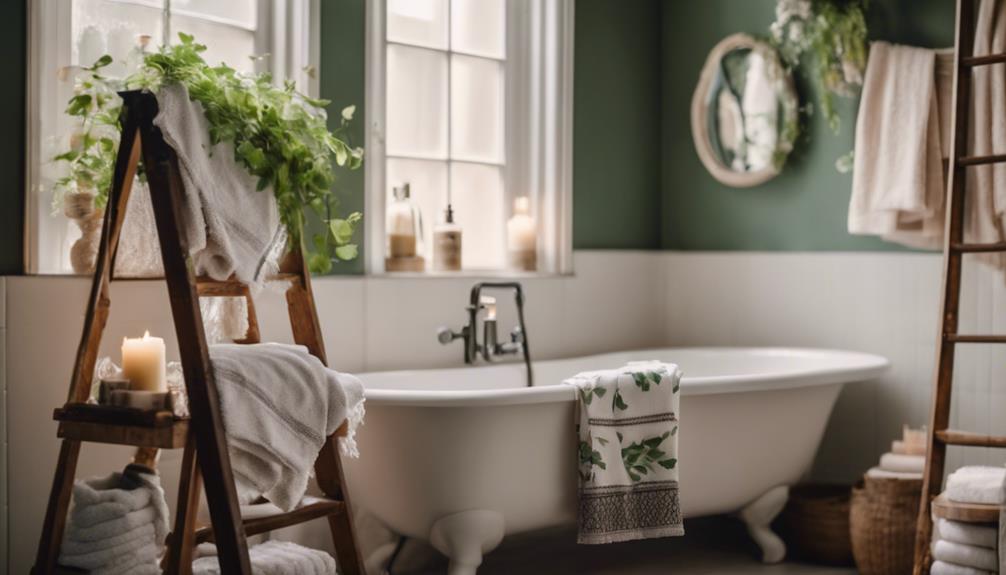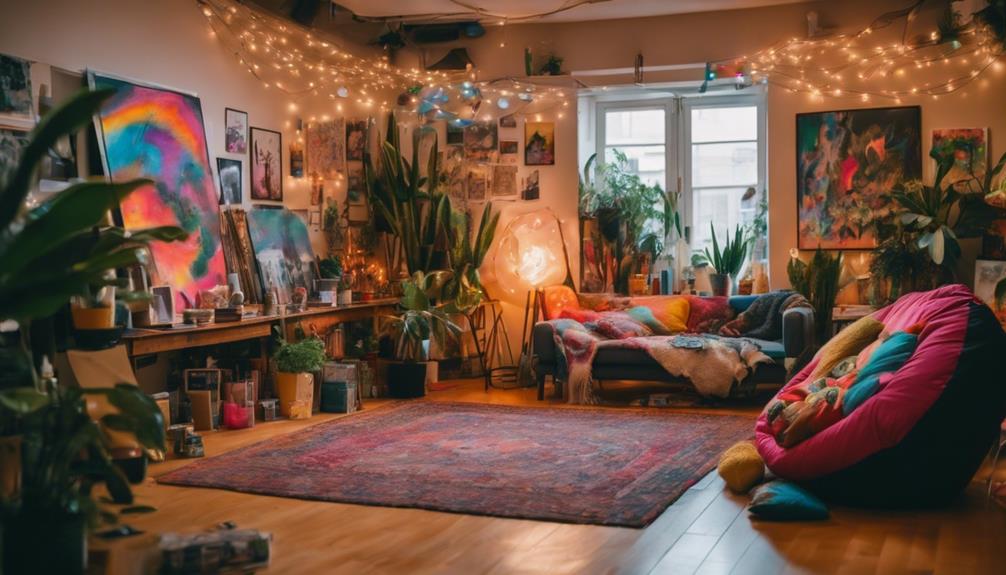Aesthetic towels can transform your bathroom into a stylish sanctuary that impresses everyone. By choosing a cohesive color palette, you reflect your personal style, while high-quality materials like Turkish cotton guarantee softness and absorbency. Mixing textures adds depth, and decorative elements like a vintage towel rack enhance both function and charm. Pair these towels with warm LED lighting for a cozy atmosphere, and consider unique accessories like a ceramic soap dispenser to elevate the décor further. Ready to elevate your bathroom game? There's more to explore about creating a beautiful, functional space that you'll love!
Key Elements

When choosing aesthetic towels for your bathroom, consider the key elements of color scheme, materials, and textures.
These factors not only enhance the visual appeal but also contribute to the overall atmosphere of your space.
Color Scheme
Choosing the right color scheme for your towels can greatly elevate your bathroom's aesthetic, creating a harmonious blend with your existing decor. Start by selecting a cohesive color palette that reflects your style—whether you prefer soft pastels for a tranquil vibe or bold hues for a vibrant touch.
Consider using complementary colors to create visual interest. This approach can transform your towels into eye-catching accents. For instance, a rich navy towel set paired with crisp white can add sophistication while maintaining a clean look.
Don't shy away from incorporating patterned towels, either. They can effectively conceal stains and wear, making them practical for everyday use.
Materials
Selecting the right materials for your towels is just as important as the color scheme, as they greatly impact both comfort and functionality in your bathroom.
One of the best options for towels is cotton, particularly high-quality varieties like Turkish cotton. These towels are renowned for their ability to absorb water efficiently, thanks to their long fibers, which enhance softness and durability.
When choosing towels, pay attention to the GSM (grams per square meter). A higher GSM, typically between 600 to 900, indicates a more plush and absorbent towel, perfect for a luxurious feel. If you prefer something lighter, consider towels with a waffle weave; they dry quickly while still providing decent absorbency.
For those who prioritize sustainability, towels made from organic cotton are an excellent choice. Not only do they offer a soft touch, but they also support environmentally friendly practices.
Additionally, some modern towels incorporate microfiber blends, which combine cotton with synthetic fibers for quick drying and stain resistance—ideal for busy bathrooms.
Textures
Textures play an essential role in enhancing your bathroom's aesthetic, offering both visual interest and functionality through various towel designs.
For instance, waffle weave towels are lightweight and quick-drying, making them a practical choice while adding a unique tactile element to your decor. Their intricate patterns not only catch the eye but also help conceal stains, promoting a lively atmosphere.
Turkish towels are another excellent option. Their thinner texture provides a stylish look, plus they're incredibly portable and fast-drying, perfect for trips to the beach or gym. By incorporating these into your bathroom, you can elevate both style and practicality.
Don't overlook the impact of plush and absorbent towels. Mixing these with textured options creates a balanced sensory experience, enhancing your comfort.
To showcase your towels, consider using decorative ladders, which add a unique textural element and display bold prints against neutral walls, further enhancing your bathroom design.
Essential Fixtures and Furniture

When it comes to creating a stylish bathroom, the right fixtures and furniture make all the difference.
Consider incorporating a vintage wooden towel rack for a touch of charm, a marble towel warmer stand for luxury, or a glass shelving unit to showcase your towels elegantly.
Each piece adds functionality while enhancing the overall aesthetic of your space.
Vintage Wooden Towel Rack
A vintage wooden towel rack instantly elevates your bathroom's charm, blending functionality with timeless style. This stylish fixture not only serves as a practical storage solution for your towels but also adds a classic aesthetic that complements both traditional and modern decor. Made from durable hardwoods, vintage towel racks often feature intricate carvings or distressed finishes, enhancing their rustic appeal and making them a standout piece in any space.
With multiple rungs or tiers, these racks offer ample room for hanging towels, keeping them organized and easily accessible. You'll appreciate how this design helps maintain a tidy bathroom while showcasing your towels as decorative elements. Opting for a vintage wooden towel rack made from sustainable materials contributes to eco-friendly home decor and guarantees lasting quality.
Incorporating this charming piece can greatly enhance the overall ambiance of your bathroom, creating a warm and inviting atmosphere that's sure to impress guests. So, if you're looking to marry style with function, a vintage wooden towel rack is an essential addition to your bathroom that you won't regret.
Marble Towel Warmer Stand
Enhancing your bathroom's elegance, a marble towel warmer stand not only looks stunning but also keeps your towels warm and dry. This essential fixture elevates your decor with its luxurious design, turning your bathroom into a spa-like retreat. The beauty of marble adds a sophisticated touch, making it a centerpiece that impresses everyone.
These towel warmers come with adjustable temperature settings, allowing you to customize the warmth according to your preference. Whether you enjoy a toasty towel after a shower or simply want to keep your linens dry, this feature guarantees your comfort. Plus, many models are equipped with energy-efficient heating elements, which means you can indulge in luxury without worrying about skyrocketing electricity bills.
Durability and heat resistance make marble the ideal material for a towel warmer. You won't have to stress about wear and tear, as these stands are built to last. With a marble towel warmer stand, you're not just adding functionality; you're enhancing the overall ambiance of your bathroom.
Glass Shelving Unit for Towels
Transform your bathroom's organization and style with a glass shelving unit for towels, effortlessly combining modern aesthetics and practicality. This sleek, transparent fixture not only keeps your towels organized but also enhances the overall aesthetic of your space.
The minimalist design of a glass shelving unit creates an illusion of openness, making it an excellent choice for smaller bathrooms where every inch counts.
Cleaning your glass shelves is a breeze, as any dust or water stains can be quickly wiped away, ensuring a pristine look that complements your towels. You can also release your creativity by mixing and matching decorative items with neatly folded towels, adding a personal touch to your bathroom decor.
Incorporating a glass shelving unit elevates your bathroom's design, contributing to a luxurious, spa-like atmosphere that transforms everyday routines into indulgent experiences.
With the perfect blend of style and functionality, a glass shelving unit is an essential addition to your bathroom, turning it into an organized sanctuary that impresses everyone who visits.
Lighting Ideas

When it comes to lighting your bathroom, you've got some exciting options to ponder.
Warm LED recessed lighting can create a cozy atmosphere, while pendant lights with natural wood add a trendy touch.
Don't forget about sconce lighting for that soft glow, and if you're lucky enough to have skylights, let that natural light shine in!
Warm LED Recessed Lighting
Warm LED recessed lighting creates a cozy atmosphere in your bathroom, making it perfect for relaxation and self-care. With a color temperature between 2700K and 3000K, these lights provide a warm glow that enhances your cozy ambiance. Their sleek design allows them to blend seamlessly into any bathroom aesthetic, ensuring your space looks modern without overwhelming the decor.
One of the biggest advantages of warm LED recessed lighting is its energy efficiency. These lights consume considerably less energy than traditional incandescent bulbs, offering up to 80% savings while lasting up to 25,000 hours. Plus, with dimming options available, you can easily adjust the brightness for different moods or tasks, whether you're unwinding in a bubble bath or getting ready in the morning.
To maximize functionality, proper placement of recessed lights is key. Position them around mirrors and vanity areas to achieve even illumination, minimizing shadows and enhancing your grooming or makeup application experience.
Pendant Lights With Natural Wood
Incorporating pendant lights with natural wood accents into your bathroom can enhance the cozy atmosphere created by warm LED recessed lighting while adding a touch of rustic charm. These lights blend modern design with organic elements, making them a perfect fit for your space. With options like oak, walnut, or reclaimed wood finishes, you can customize the look and feel of your bathroom to match your existing decor effortlessly.
Not only do these pendant lights elevate your aesthetic, but they also provide stylish illumination using energy-efficient LED bulbs. This means you can enjoy beautiful lighting without worrying about high electricity bills. The adjustable height during installation allows you to create an inviting ambiance, whether your ceiling is high or low.
Pair your new pendant lights with the best towels on Amazon to complete the look. Select bath towels that complement the wood tones and add a splash of color. The combination of warm lighting and plush bathroom towels will turn your bathroom into a cozy retreat, impressing anyone who visits.
Make your space not just functional, but also a stylish haven.
Sconce Lighting With Soft Glow
Sconce lighting adds an elegant touch to your bathroom, creating a soft glow that enhances both aesthetics and ambiance. By choosing wall-mounted sconces, you can save space while introducing visual interest, making them perfect for smaller bathrooms where traditional fixtures mightn't fit.
One of the great benefits of sconce lighting is the availability of dimmable options, offering adjustable lighting for various occasions. Whether you want a relaxing atmosphere for a long soak in the tub or a bright, functional space for your daily routines, sconces provide the versatility to meet your needs.
Additionally, installing sconces on either side of your mirror not only reduces shadows but also makes tasks like shaving or applying makeup easier. This strategic placement turns your lighting into a stylish focal point that elevates your bathroom's design. With a variety of styles and finishes, from modern to vintage, you can easily customize sconce lighting to complement your personal decor.
Incorporating sconce lighting into your bathroom design will certainly impress everyone who steps inside while providing the functional illumination you need.
Natural Light From Skylights
Skylights can transform your bathroom by flooding it with natural light, creating a bright and airy atmosphere. By increasing natural light by up to 30%, they enhance the overall brightness and make the space feel more inviting. You'll notice a significant reduction in your energy costs, as these windows minimize the need for artificial lighting during daylight hours.
Beyond aesthetics, skylights also improve ventilation, which is essential for maintaining healthy humidity levels. Proper airflow can help reduce excess moisture, preventing mold growth, a common concern in bathrooms. With various styles available, including fixed, venting, and tubular designs, you can customize your skylights to fit your bathroom's aesthetic and functional needs.
Additionally, consider energy-efficient glazing options for your skylights. This choice won't only maximize natural light but also enhance insulation, keeping your bathroom warmer in winter and cooler in summer.
Embracing natural light through skylights can transform your bathroom into a stylish and functional retreat, impressing everyone who walks in. So, why not explore installing skylights to elevate your bathroom experience?
Decorative Elements

To really elevate your bathroom's vibe, consider adding a framed botanical print, a stylish ceramic soap dispenser set, and a succulent in a decorative pot.
These elements not only enhance the aesthetic but also create a cohesive look that ties everything together.
With just a few thoughtful touches, your space can feel both inviting and sophisticated.
Framed Botanical Print
Framed botanical prints instantly elevate your bathroom decor, infusing it with a revitalizing touch of nature that promotes a serene atmosphere. These prints not only enhance the overall aesthetic but also create a calming environment that transforms your space into a personal retreat. You can customize framed botanical prints in various sizes and styles to suit your design theme, whether it's modern, rustic, or somewhere in between.
To maintain their integrity in humid conditions, choose high-quality, moisture-resistant frames. This guarantees your artwork remains vibrant and appealing, even in the steamiest of bathrooms. When you pair these beautiful prints with aesthetically pleasing towels, you create a harmonious and stylish look that impresses everyone who visits.
Incorporating botanical prints can foster a spa-like ambiance, making your bathroom feel like a serene getaway. They serve as a focal point that draws the eye and complements your other decorative elements.
Ceramic Soap Dispenser Set
A ceramic soap dispenser set instantly elevates your bathroom's style, combining functionality with a touch of sophistication. These elegant dispensers come in various colors and patterns, allowing you to choose one that perfectly complements your decor.
With a durable, chip-resistant finish, they're designed to withstand the wear and tear of daily use while maintaining their aesthetic appeal. The pump mechanism in these sets allows for controlled dispensing of liquid soap, minimizing waste and mess compared to traditional soap dishes.
Plus, the weight of ceramic guarantees stability, reducing the risk of spills or tipping—ideal for high-traffic bathrooms. To create a cohesive look, consider pairing your ceramic soap dispenser set with coordinating accessories, like toothbrush holders or lotion dispensers.
This not only enhances your bathroom's visual appeal but also adds a sophisticated touch that impresses guests. Investing in a ceramic soap dispenser set is a smart choice for anyone looking to elevate their bathroom decor while guaranteeing practicality.
With its combination of style and function, it's a simple yet effective way to transform your space into an elegant retreat.
Succulent in a Decorative Pot
Succulents in decorative pots bring a vibrant touch to your bathroom while requiring minimal care. These low-maintenance plants thrive in well-drained soil, making them ideal for a space where humidity levels can fluctuate.
By incorporating succulents into your bathroom decor, you not only enhance the visual appeal but also improve air quality. They filter toxins and release oxygen, creating a fresher environment.
When choosing decorative pots, you'll find a variety of materials, including ceramic, terracotta, and metal, which allows you to personalize the aesthetic to fit your style. Layering different types or colors of succulents in these pots can create an alluring focal point that draws the eye.
It's essential to select pots with drainage holes to prevent overwatering, ensuring your succulents remain healthy and vibrant. This step helps maintain the right moisture balance, which is vital in a bathroom setting.
Flooring

When it comes to flooring in your bathroom, you've got some stylish options to contemplate.
Textured stone tile flooring can add a touch of elegance, while vinyl plank with a wood finish offers a budget-friendly alternative that looks great.
If you're after warmth and comfort, cork flooring might be the perfect eco-friendly choice for your space.
Textured Stone Tile Flooring
Textured stone tile flooring provides a stylish and practical solution for bathroom spaces, offering both safety and aesthetic appeal. These textured materials are specifically designed to create a non-slip surface, which is essential in areas prone to water exposure. This feature greatly enhances safety, allowing you to move confidently around your bathroom.
You'll find textured stone tiles available in various natural materials like granite, marble, and slate. Each option offers unique patterns and colors that can complement your existing decor, adding a touch of sophistication to your space. Plus, the uneven surface of these tiles helps hide dirt and scratches, making them a durable choice for high-traffic areas.
Investing in stone tiles means you're opting for a highly durable flooring solution that resists moisture effectively. To maintain their beauty and longevity, regular maintenance is key. Simple tasks like sealing the tiles and cleaning with pH-neutral products can help preserve their appearance for years to come.
With textured stone tile flooring, you're not just enhancing your bathroom's style; you're also making a smart investment in safety and durability.
Vinyl Plank With Wood Finish
Vinyl plank flooring with a wood finish offers an attractive, water-resistant option that perfectly suits the needs of any bathroom. This flooring mimics the look of natural hardwood, providing you with the aesthetic appeal of oak, maple, or hickory without the downsides of moisture damage. It's especially beneficial in high-moisture areas where bath towels might otherwise struggle to stay dry.
Thanks to its durable wear layer, vinyl plank flooring resists scratches and stains, ensuring that your space maintains its beauty even with everyday use. Plus, the added comfort it provides makes your bathroom a more inviting environment. You'll love the feeling of stepping onto a super plush surface after a shower, enhancing your overall experience.
Installation is a breeze, whether you opt for a click-lock system or glue-down method, making it a great DIY project. The water resistance of vinyl plank flooring allows bath towels to dry faster, helping to keep your bathroom tidy and fresh. With this stylish and functional flooring, you can create a comfortable retreat that impresses everyone who walks through your door.
Cork Flooring for Warmth
Cork flooring brings a cozy warmth to your bathroom, making it an inviting space even on the coldest mornings. This eco-friendly option is crafted from the bark of cork oak trees, which regenerate after harvesting, ensuring sustainability. With its natural insulation properties, cork flooring helps maintain warmth, potentially lowering your heating costs.
You'll love how comfortable it feels underfoot. The cushioned surface is gentle on your joints, perfect for those times when you spend longer standing in front of the mirror or getting ready. Plus, cork's inherent sound-dampening qualities create a tranquil atmosphere, reducing noise levels and enhancing your bathroom experience.
Another significant advantage is its resistance to mold and mildew, thanks to suberin, a natural compound within cork. This means you can enjoy a healthier indoor air quality, providing peace of mind.
Incorporating cork flooring into your bathroom not only elevates its aesthetic appeal but also transforms it into a warm, functional space that impresses everyone. So, if you're looking for a stylish yet practical flooring solution, cork is definitely worth considering.
Conclusion
Incorporating aesthetic towels into your bathroom can truly elevate the space, blending style with functionality.
By choosing the right fixtures, lighting, and decorative elements, you'll create an inviting atmosphere that impresses everyone who steps in.
Don't overlook the flooring, as it ties the whole look together.
So go ahead, add those stylish towels and watch how they transform your bathroom into a chic haven that reflects your unique taste!









